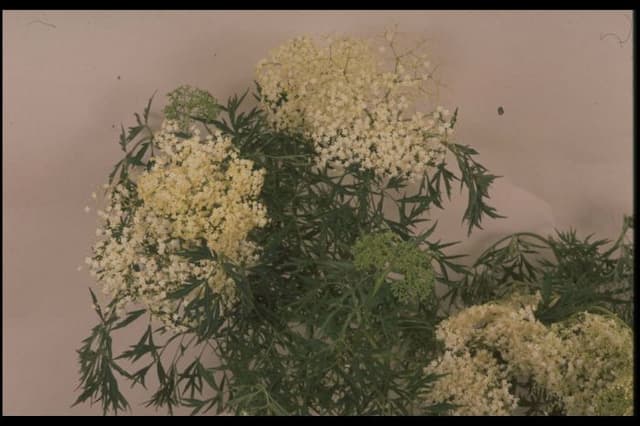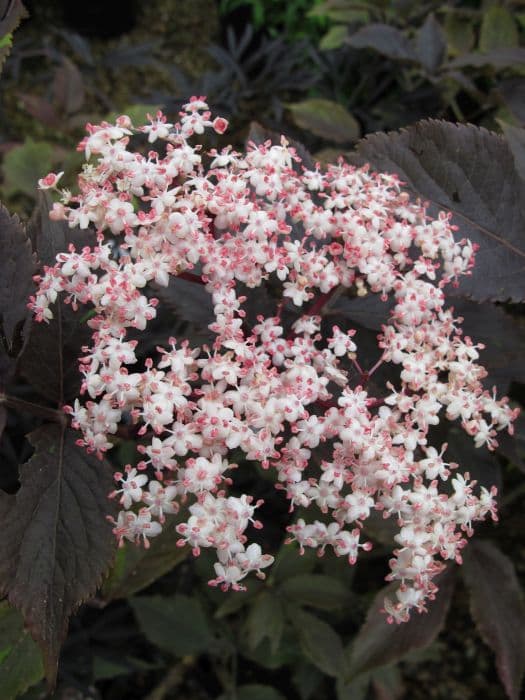Koreanspice viburnum Viburnum carlesii 'Diana'

ABOUT
The Viburnum carlesii 'Diana', commonly known as Korean Spice Viburnum, is a deciduous shrub that is admired for its highly fragrant flowers. In early spring, the plant is adorned with clusters of pink buds that open to reveal white, snowball-like blooms. These flowers exude a rich, spicy-sweet fragrance that can perfume the air around it. During the bloom period, the individual flowers are small, tubular and arranged in spherical clusters, creating an attractive textural contrast against the foliage. The leaves of the Korean Spice Viburnum are broad and oval-shaped, with a deep green hue that can have a glossy texture giving the plant a lush, vibrant look. As the seasons change, the foliage of the Viburnum carlesii 'Diana' transitions to stunning autumn hues, often presenting a mix of red, yellow, and purple shades that add another layer of visual interest to the garden. The overall form of the plant is rounded, with a dense, bushy growth habit that provides a substantial presence in the landscape. The branches are sturdy and spread outward, holding the leaves and flowers in a way that makes them readily visible and enjoyable to passersby. It's also important to note that the Korean Spice Viburnum can produce small, round fruits that start out red and mature to a dark, almost black hue. These berries can attract birds and wildlife, adding another element of life to the garden where this plant is situated.
About this plant
 Names
NamesFamily
Adoxaceae
Synonyms
Koreanspice Viburnum, Korean Spicebush, Mayflower Viburnum
Common names
Viburnum carlesii 'Diana'.
 Toxicity
ToxicityTo humans
The Korean spice viburnum is generally not considered toxic to humans. However, ingestion of any plant material may cause gastrointestinal discomfort in some individuals. There are no severe toxicity issues associated with this plant for humans.
To pets
The Korean spice viburnum is also generally not considered toxic to pets. Like in humans, ingestion of plant parts might result in mild stomach upset for some animals, but it is not known to cause serious poisoning or long-term health issues in pets.
 Characteristics
CharacteristicsLife cycle
Perennials
Foliage type
Deciduous
Color of leaves
Green
Flower color
Pink
Height
4-6 ft (1.2-1.8 m)
Spread
4-6 ft (1.2-1.8 m)
Plant type
Shrub
Hardiness zones
4-7
Native area
Korea
Benefits
 General Benefits
General Benefits- Aesthetic Appeal: This plant produces fragrant, showy flowers that enhance the beauty of any garden.
- Attracts Wildlife: The blooms offer nectar to butterflies while birds are drawn to the berries.
- Seasonal Interest: Offers a long period of interest with spring blooms, summer foliage, and sometimes reddish leaves or fruit in fall.
- Easy to Grow: Adaptable to a wide range of soils and conditions with minimal care requirements.
- Dense Foliage: Provides a lush backdrop in garden designs and can be used for privacy hedges or screens.
- Hardy: It is known for being cold-tolerant, making it suitable for gardens in cooler climates.
- Deciduous Nature: Adds to the seasonal dynamics of a garden with its changing leaves.
- Low Maintenance: Requires minimal pruning and is relatively free from major pest and disease problems.
- Versatile Landscaping: Suitable for use in borders, hedges, or as a focal point in the garden due to its size and shape.
 Medical Properties
Medical PropertiesThis plant is not used for medical purposes.
 Air-purifying Qualities
Air-purifying QualitiesThis plant is not specifically known for air purifying qualities.
 Other Uses
Other Uses- Privacy Screening - Viburnum carlesii 'Diana' can be planted in rows to create a dense privacy screen that blocks out unwanted sights and muffles sound.
- Topiary - With regular trimming, this easy-to-shape plant can be crafted into ornamental forms and topiaries, serving as focal points in garden designs.
- Windbreaks - The thick foliage of the Viburnum can provide protection against winds when planted in strategic locations around a property.
- Erosion Control - The robust root system helps stabilize soil on slopes, thus preventing erosion.
- Habitat for Wildlife - Provides food in the form of berries and foliage for birds and other wildlife, while also offering shelter and nesting sites.
- Photography Prop - The vibrant blooms and attractive foliage make it a desirable backdrop for garden photography and portraiture.
- Seasonal Decoration - Branches with flowers or berries can be cut and brought indoors for natural, seasonal décor.
- Boundary Marking - These plants can be used as a natural way to delineate property lines, without the need for fencing.
- Cultural Significance - In some cultures, Viburnum plants are used in traditional celebrations and ceremonies as symbols of growth and renewal.
- Living Sculpture - Creative gardeners can train Viburnum hedges into living sculptures, sometimes referred to as 'green' art.
Interesting Facts
 Feng Shui
Feng ShuiThe Korean Spice Viburnum is not used in Feng Shui practice.
 Zodiac Sign Compitability
Zodiac Sign CompitabilityThe Korean Spice Viburnum is not used in astrology practice.
 Plant Symbolism
Plant Symbolism- Renewal: Viburnum carlesii 'Diana', commonly known as Koreanspice viburnum, flowers in the early to mid-spring, showcasing the awakening of nature and symbolizing fresh beginnings.
- Beauty and Elegance: With its beautiful and fragrant flowers, Koreanspice viburnum represents beauty and elegance, often appreciated in gardens for its aesthetic appeal.
- Perseverance: Koreanspice viburnum is a hardy shrub that can withstand various conditions, embodying the quality of perseverance and resilience in adversity.
 Water
WaterThe Korean Spice Viburnum should be watered deeply and thoroughly, providing the soil with even moisture but allowing it to dry slightly between waterings to prevent waterlogging. Typically, during the growing season, it may need watering once a week, but this can vary depending on weather conditions. In the absence of rain, aim for approximately 1 to 1.5 gallons of water per week for an established plant. Younger or transplanted shrubs may need more frequent watering, like two to three times a week, until their root systems are fully established.
 Light
LightThe Korean Spice Viburnum thrives in areas with full sun to partial shade. It performs best when it receives at least six hours of sunlight a day, but it can also tolerate and bloom in partial shade. The ideal spot for this plant is one where it can soak up the morning light and receive protection from the harsh afternoon sun, especially in hotter climates.
 Temperature
TemperatureThe Korean Spice Viburnum does well in a wide range of temperatures but prefers a moderate climate. It can typically withstand temperatures as low as 0 degrees Fahrenheit and as high as 80 degrees Fahrenheit. The optimal growing temperature range is between 60 and 75 degrees Fahrenheit, ensuring healthy growth and flowering.
 Pruning
PruningPruning the Korean Spice Viburnum is necessary to maintain its shape and promote vigorous growth. It is best to prune immediately after flowering in late spring or early summer, to avoid cutting off next year's buds. Removing old or crossed branches and thinning out the shrub every few years encourages better air circulation and light penetration.
 Cleaning
CleaningAs needed
 Soil
SoilThe Korean Spice Viburnum prefers moist, well-draining soil with a high organic content. A soil mix of garden loam, leaf mold or compost, and some sand or perlite to improve drainage is ideal. The optimal soil pH for Korean Spice Viburnum is slightly acidic to neutral, around 5.5 to 7.0.
 Repotting
RepottingKorean Spice Viburnum is typically grown in the ground and does not require frequent repotting. If grown in a container, repot it every 2-3 years or when the plant becomes root-bound.
 Humidity & Misting
Humidity & MistingKorean Spice Viburnum thrives in average outdoor humidity levels. It does not require any special humidity requirements when grown in its preferred outdoor environment.
 Suitable locations
Suitable locationsIndoor
Provide bright light, ensure good air circulation.
Outdoor
Plant in well-draining soil, partial to full sun.
Hardiness zone
4-8 USDA
 Life cycle
Life cycleThe Korean Spice Viburnum 'Diana' starts its life cycle when its seeds germinate, often in spring, with ideal conditions of moist soil and partial sunlight. The seedling then develops into a young plant with soft, green foliage and begins to establish a root system. As it matures, the shrub experiences vegetative growth, producing dense, dark green leaves and building a woody structure. During spring, it enters the reproductive stage, displaying fragrant pink to white flower clusters that attract pollinators and ultimately produce red to black berries in the fall. The plant reaches maturity in several years, during which it continues to flower annually while it thickens and its height and spread increase. As the shrub ages, it may enter a phase of decline where growth slows and it becomes more susceptible to environmental stresses or disease, eventually leading to the end of its life cycle.
 Propogation
PropogationPropogation time
Spring to Early Summer
The Viburnum carlesii 'Diana', commonly known as Korean Spice Viburnum, is most successfully propagated by softwood cuttings in late spring to early summer when new growth is just beginning to harden but is still flexible. To propagate, take a cutting of about 4 to 6 inches (10 to 15 centimeters) long, making sure it has several leaf nodes. Strip the leaves from the bottom half of the cutting and dip the cut end in rooting hormone to encourage root growth. Then, plant the cutting in a moist potting mix, ensuring at least two leaf nodes are buried below the surface. Covering the pot with a plastic bag can help maintain humidity, but it should not touch the leaves directly. Keep the soil moist and wait several weeks for the cutting to root before transplanting it to a more permanent location.









